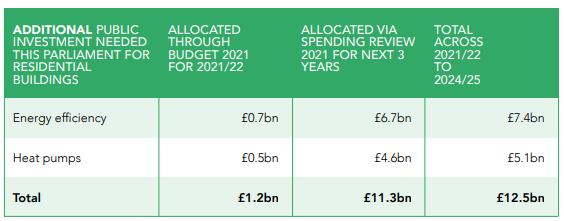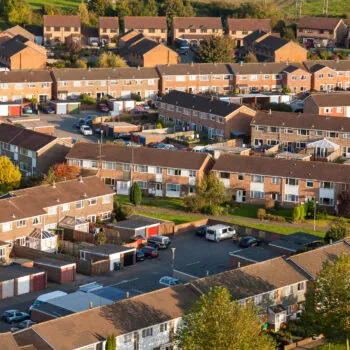Homes were a central strand of the UK Government’s green recovery promises last year. Over £3bn was committed to making houses and buildings more efficient and cheaper to run, less dependent on fossil fuel heating sources, while getting the UK on track to meet climate targets.
However, despite Boris Johnson’s promise we’ll never be lagging on lagging, the well-intended Green Homes Grant scheme has been beset by troubles. Despite the scheme’s popularity – with pre-polling finding that over 60% of households were interested in the grants – industry and public confidence in the scheme has been significantly undermined by administrative problems and delays. Even more concerning, many installers are yet to be paid for the work they have done by the American contractor running the scheme.
The UK will lose international credibility regarding its ability to deliver on a green recovery if it jeopardises progress on green homes through withdrawing underspend. With the eyes of the world on the UK in the run up to the G7 and COP 26 summits, it is crucial to show leadership through rapidly learning and applying lessons from the Green Homes Grant. Further support is needed for skills and supply chains – and a full roll-over of funding must be confirmed at the Budget.
Sorting out the Green Homes Grant is just the first step for getting on track to decarbonise homes across the UK. 2021 will be a critical year for making progress on place-based transitions, with important decision-making through the Budget and Spending Review, as well as the Heat & Buildings Strategy, Fuel Poverty Strategy, and establishment of a new National Infrastructure Bank. Ambition and investment must be secured through this raft of decision-making if the UK is to achieve the scale and pace needed this decade. The Energy Efficiency Infrastructure Group (EEIG) – a coalition of over 25 industry groups, NGOs and businesses, including E3G – sets out its expectations in a new briefing, correcting the course from the Green Homes Grant and moving towards a long-term green recovery.
Meeting the funding shortfall through the Budget and Comprehensive Spending Review
The EEIG has crunched the numbers and found that – even with a full roll-over of the Green Homes Grant – current spending commitments fall short of what’s needed to get on track to meet the EEIG’s vision of all homes achieving an EPC rating of at least C by 2030, and heat pump deployment consistent with the Climate Change Committee’s ‘Balanced Pathway’ to net zero.
The table below outlines new commitments required from the forthcoming Budget and Spending Review. This should include confirmation of the unallocated £9.2bn promised for energy efficiency in the Conservatives Manifesto, with only £1.735bn committed so far.

The Government must confirm roll-over of the Green Homes Grant underspend as a priority, to provide confidence to industry and consumers to invest in the green homes, skills and supply chains needed to get on track for zero emissions. The Government also needs to confirm the Manifesto spending commitments for the Home Upgrades Grant and social housing decarbonisation fund, as well as announcing new incentives, such as Green Stamp Duty, to spur households to undertake green retrofits.
Accelerating and coordinating action through the Heat and Buildings Strategy
The Heat & Buildings Strategy – to be launched imminently by BEIS – must set the vision, targets, framework and mandate to get the UK on track for green recovery and to meet its climate targets and interim carbon budgets – including the Climate Change Committee’s 6th Carbon Budget, and Nationally Determined Contribution to reduce emissions by 68% by 2030. This must encompass the full range of measures needed, including but not limited to:
- Updating targets and regulations on energy efficiency and heat. This should include a new target to ensure as many homes as possible reach at least EPC C by 2030 (with progress made on improving EPCs as a yardstick for decarbonisation), and new targets and regulations on heat decarbonisation that reflect climate science. A roadmap should be set out for introducing minimum energy efficiency and carbon standards for the owner-occupied sector – within which the largest climate gains are to be made.
- National and local mandates for action: The Strategy should provide a mandate for local action and leadership through heat zoning, with Local Authorities properly equipped and financed to achieve ambitious outcomes. At a national level, a timeline for phasing out fossil fuel heating can set the direction of travel, similar to the forthcoming ban on non-electric cars.
- Supporting skills, supply chains and engagement: A Heat Pump Sector Deal and other actions are needed to scale up skills and supply chains for heat and energy efficiency, supporting quality assurances and consumer protection. A public communications and education campaign can support the scaling up of individual and community action for investment into green homes and neighbourhoods, with a role for new digital tools such as building renovation passports.
Seizing opportunities through the National Infrastructure Bank
To get to net-zero , there is a £360bn investment opportunity in the built environment, and the UK’s new National Infrastructure Bank presents an opportunity to catalyse new private and blended capital at scale, including through the provision of zero-interest loans. Treasury should ensure a net-zero built environment is a priority area from launch of the Bank. The Bank can play an important role in supporting the transition, for example through providing technical assistance and lending to local authorities, offering concessional loans to households and SMEs, and loan guarantees for social housing retrofits to the highest standard.
From Green Homes Grant to a long-term green recovery
Lessons must be quickly learnt and applied from the Green Homes Grant, but short-lived stimulus measures can only ever offer so much. The economic and employment offering of green homes can only meet its full potential through a long-term investment programme: boom-and-bust cycles linked to short-term policies create uncertainty and investment reluctance for industry, finance and consumers.
A well-executed, long-term home decarbonisation programme could support 190,000 green jobs to 2030 in energy efficiency and low carbon heat across the UK, while reducing household energy expenditure by £7.5bn per year. In the run-up to COP 26, the UK is under an international spotlight to showcase successful delivery of a green recovery which is more than just a pipedream. Through the forthcoming suite of policies and investment decisions, the UK has a unique opportunity to move from laggard to leader on place-based transitions.



